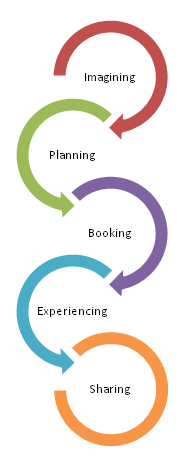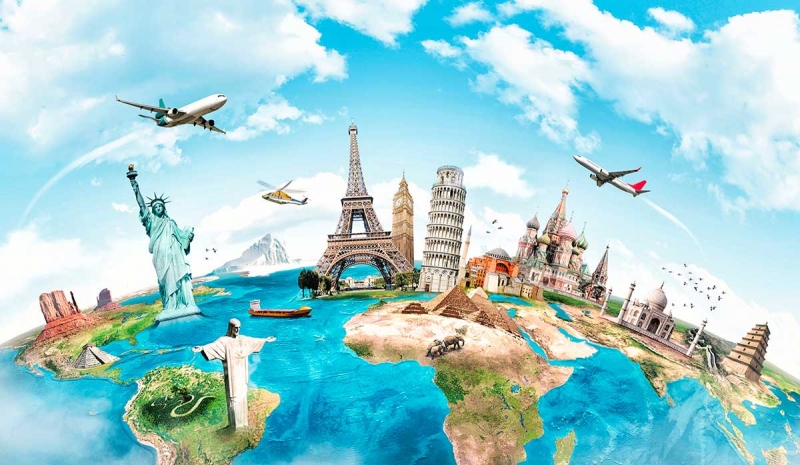Understand Your Visitors, Improve Your Offering
Tourism is one of the largest economic activities, with statistics indicating that people spend more discretionary income on travel than on home improvement, financial investment, or even health.
But how people travel is changing. For example, people are spending more and more time researching trip details on their mobile devices. In 2016, 40% of US travel site visits and 60% of searches for destination information came from mobile devices, and travelers are increasingly consuming and publishing information on tourism in online travel agencies, social networks, or review sites such as TripAdvisor, Booking.com, etc.
A new generation of contextual semantic analysis applications allow us to leverage all that information and communicate more naturally with hyperconnected tourists. These applications range from analyzing comments on social media to understanding natural language which allows us to develop much more conversational assistants and bots.
In this article, we review some of these applications. But first, let’s start by analyzing what the new “tourist journey” is.
The new tourist journey
 New travelers are permanently connected using mobile and social media, and these new channels are modifying their “customer journey” in a spectacular way. The new tourist journey consists of the following phases:
New travelers are permanently connected using mobile and social media, and these new channels are modifying their “customer journey” in a spectacular way. The new tourist journey consists of the following phases:
- Imagining. Potential visitors begin to imagine/dream of a new trip to a certain destination, and they seek inspiration from all types of information and shared experiences, both offline and online.
- Planning. They research transportation, accommodation, and activities using various sources of information. They identify various suppliers and compare them using data and opinions available in comparison tools, forums, etc.
- Booking. They make a decision, select suppliers, and book the trip.
- Experiencing. They enjoy the trip, in an experience that goes from the preparatory phase before the travel, to the trip itself, to the memories made while traveling. If the experience meets or exceeds travelers’ expectations, they may become repeat customers.
- Sharing. They share their experiences, both positive and negative, with friends and followers, becoming either ambassadors or detractors of the brand.
This new reality raises different needs for both supply and demand in the tourism industry:
- Supply: Destinations, suppliers, establishments, and promotion agencies need to know what the market thinks of them (reputation, perceptions, brand associations, etc.). They must be able to understand and model their potential clients (their preferences, affinities, opinions, intentions, and phase in their journey) both at an individual and aggregate level. This understanding will help them improve their offering, gain access to their prospective customers, and be relevant in the different stages of their travel process.
- Demand: Travelers want to travel with zero conflict from start to finish: to be provided with useful and relevant information, suggested destinations based on their preferences, tips to optimally organize their trip, and risk-free purchases. They require assistance to enjoy their trip and their stay and, finally, to share their experiences in their various circles.
With this new perspective, let’s analyze the applications for semantic analysis in various scenarios of the tourism industry.

Semantic analysis technologies to understand clients
Who are the potential visitors to your destination, and what are they like? What are their wishes, concerns, and fears? How do they change according to their country of origin or their socio-economic situation? Semantic analysis technology allows us to automatically analyze, with high quality and low cost, the millions of spontaneous opinions that travelers pour into social networks, forums, and review sites and turn them into high-value insights.
We can work at the individual client level and analyze the social content they publish in order to profile them, inferring a series of attributes:
- Demographics: person/organization, age, gender, location, etc.
- Psychographic and lifestyle attributes: education, profession, purchasing power, family, possessions such as home and automobile, sentiment (polarity of their opinions on various aspects), attitudes, affinities, interests, fears, conversation topics, and more.
- About their customer journey: needs, requirements, intentions, phase in the journey, purchase/recommendation/criticism signals, etc.
In addition to profiling individual users, we can go a step further and analyze profile sets to synthesize aggregate representations of our potential clients that enable us to model and represent them in a more general way. These representations can take various forms:
- Segment: a “macroscopic”, abstract and aggregated definition of a set of clients that share common characteristics. For example, we can define the segment of prospective travelers from China who are interested in Spain’s cultural offerings.
- Persona: an archetype that is constructed to represent a type of client in a “microscopic”, concrete and detailed way. A persona is an empathic representation of a subset of clients that usually serves to illustrate and explain a segment in detail. For example, we can define the archetype of Wang, a potential Chinese tourist, with his motivations, objectives, criteria, fears, behaviors and favorite communication channels.
Together, these artifacts help us identify, quantify, and evaluate market opportunities; focus on the most interesting ones; and design buyer and user experiences (such as service offerings and marketing campaigns) that are focused on different customer categories.
Semantic analysis technologies to discover the market’s opinion
What does the market think of us? How do they perceive us? What do they value the most and the least? How do they compare us with our competitors? We can automatically analyze millions of opinions spontaneously provided by travelers, but instead of making the client the object of analysis, we analyze the destination. Some of the insights we can obtain are:
- Sentiment analysis: What is the positive/negative/neutral polarity of the opinions on my offering? What are the most positive/negative aspects that are talked about?
- Reputation: What is the market’s opinion regarding a series of standard reputational dimensions that affect my brand?
- Brand associations: When the market talks about us, what concepts, entities, and attributes are most often associated with our name?
- Comparison with the competition: How do we compare with our competitors in terms of the previous insights?
- Trends: How do the previous insights change over time?
These insights can form the basis of a monitoring and benchmarking system that allows us to detect our strengths and weaknesses with respect to the market, thus promoting the former and overcoming the latter.
Semantic analysis technology in travel ideation and planning
The initial phases of the tourist jpuirney are more exploratory and “open” stages, where the information is less structured and where semantic technology can play an essential role:
- When choosing a tourist destination, virtual assistants can help by offering alternatives based on abstract descriptions (made in natural language) of the traveler’s wishes and the objectives of the trip.
- When evaluating a possible destination, chatbots can answer questions (asked using natural language) about the activities and attractions that are most suitable for the traveler in the destination.
Semantic analysis technology in the travel experiencing phase
One way that semantic technology can help provide an excellent experience for travelers is through the application of virtual assistants and bots. We can develop a mobile app to help travelers navigate the region in a contextual and dynamic way, offering them a tailored experience based on their own interests and preferences. This app could offer travelers a personal assistat service that incorporates expert knowledge about the area and its museums, shows, restaurants, and shops, thus helping them optimize their stay by alerting them to local attractions that are more in tune with their affinities in each moment.
Instantly collecting spontaneous feedback from tourists can also offer your organization insights on how to improve customer experience and thus increase satisfaction and encourage repeat visits. We expect to advance even more in that vision that “mobile is the ultimate tour guide”, combining cognitive technology with geolocation and AR/VR to provide a fully personalized and immersive experience.
Our experience
MeaningCloud provides the most complete, integrable, and adaptable set of semantic analysis APIs in the market, and we have used it successfully in various initiatives for the tourism sector:
- Automatic development of traveler data repositories based on social media content
- Multilingual exploitation of reviews of establishments
- Tourist information systems
If you need more information or want to learn how MeaningCloud can help you know your potential clients better or monitor the market’s opinion about your destination/establishment, do not hesitate to contact us at sales@meaningcloud.com.

